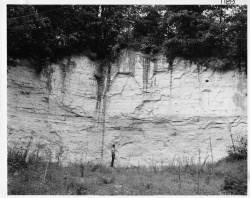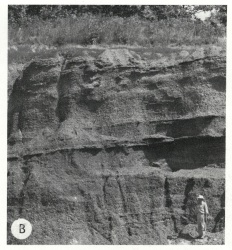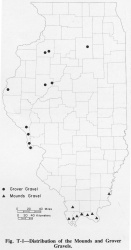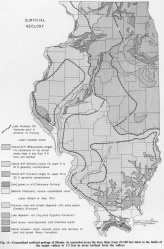Cenozoic Erathem
Chronostratigraphy: Cenozoic Erathem
Primary source
Willman, H. B., Elwood Atherton, T. C. Buschbach, Charles Collinson, John C. Frye, M. E. Hopkins, Jerry A. Lineback, and Jack A. Simon, 1975, Handbook of Illinois Stratigraphy: Illinois State Geological Survey Bulletin 95, 261 p.
Contributing author(s)
H. B. Willman and John C. Frye
Name
Original description
Cenozoic Era (Philips, 1840).
Derivation
The term Cenozoic means "recent life."
Other names
History/background
Type section
Type location
Type author(s)
Type status
Reference section
Reference location
Reference author(s)
Reference status
Stratigraphic relationships
The Cenozoic Erathem-- the strata deposited during the Cenozoic Era (Philips, 1840)-- consists of the Tertiary and Quaternary Systems, which comprise all deposits in Illinois younger than those of the Cretaceous System of Mesozoic age, including those now being deposited.
Only a minor unconformity separates the oldest Cenozoic (Tertiary) strata from the youngest Mesozoic (Cretaceous). As the Oligocene and Miocene Series are not present in Illinois, a prominent unconformity separates the oldest Tertiary (Paleocene and Eocene) from the youngest Tertiary (Pliocene) rocks. A major unconformity also separates the Tertiary from the Quaternary. However, because the Cretaceous and Tertiary Systems are missing in much of Illinois, the Quaternary System, which covers more than 95 percent of the state, lies directly and unconformably on Paleozoic rocks in most places.
Extent and thickness
Except for small areas, mainly in western and northern Illinois, rocks of Tertiary age are restricted to extreme southern Illinois (figs. K-1, T-1), whereas deposits of Quaternary age occur throughout the state (fig 11).
|
Lithology
The older, Tertiary rocks include marine deposits of the Mississippi Embayment, whereas the younger are entirely continental. The Quaternary strata include the glacial deposits that cover 80 percent of Illinois, the loess that mantles nearly all of the state, floodplain alluvium along the rivers and streams, lake and swamp deposits in some lowland areas, sand dunes on terraces and bordering uplands, and the soils that have been developed on most of these deposits.
Core(s)
Photograph(s)
Contacts
Well log characteristics
Fossils
Many of the Cenozoic rocks are abundantly fossiliferous, and even the oldest have many species nearly like those of the present day.
Age and correlation
Environments of deposition
Economic importance
Remarks
References
PHILLIPS, J., 1840, Penny cyclopedia: v. 17, p. 153-154.
ISGS Codes
| Stratigraphic Code | Geo Unit Designation |
|---|---|




